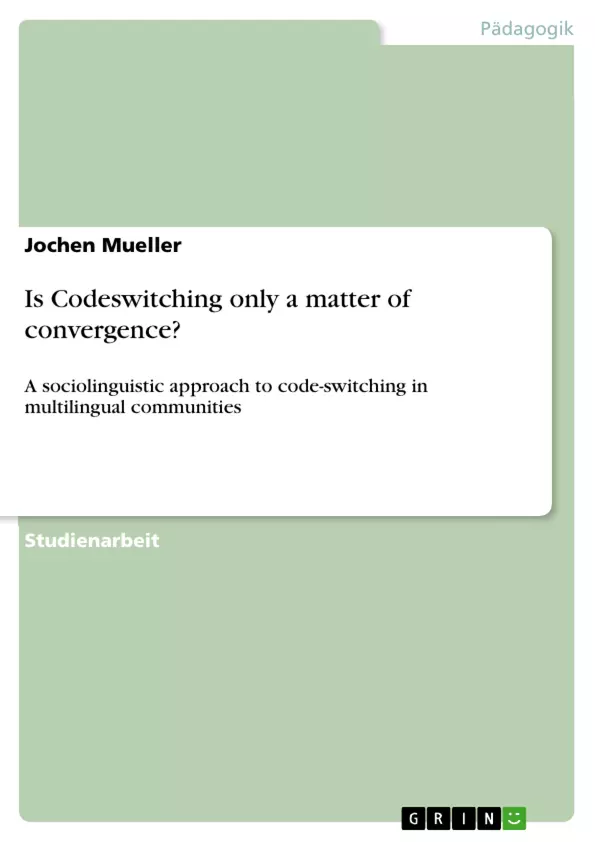Code- switching (CS) is a worldwide phenomenon and has been the norm in many different
communities, but it was unnoticed and neglected by researchers for years. However, due to
social changes, such as globalization and immigration, CS has surfaced in new places and
thereby attracted attention. Nevertheless, those linguistics who researched into the
occurrences of CS mostly commented on it negatively and categorized it as a form of
interference and broken language. The perception of CS changed when Blom and Gumperz in
1972 focused on CS between dialects in a Norwegian fishing village and pointed at its social
dimension and function. As a result, further studies of CS in various parts of the world were
introduced and up until today it is a major research topic. Especially, the motivations for CS
remain an interesting focus for those studies. Moreover, globalization and with this, the
formation of multi-ethnical societies with a variety of different languages in a country is an
on-going process and hence a late- breaking topic. Different sociolinguistic theories to explain
this phenomenon have been developed. Two well-known approaches are Giles’s Speech
Accommodation Theory, nowadays revised as Communication Accommodation Theory
(CAT) and Myers- Scotton’s Markedness Model (MM). The first has its basis in psychology
as it explains CS as a form of accommodation to converge to the addressee in order to become
more alike and therefore narrow social distance. In contrast, the socio-psychological MM also
takes macro-level perspectives into consideration and provides a generalization about how
motivations for CS are interpreted. In this paper I will focus on CS in multilingual societies
and examine, whether this process is only a matter of convergence as CAT claims. Further, I
will match this theory with the MM as it is the leading model in terms of CS in multilingual
communities.
First, I am going to explain the basic theory of both approaches. After the establishment of a
profound theoretical basis, I will introduce a study by Burt, who re-examined CAT’s claim
that every code- switch is motivated by convergence, respectively divergence. By this, the
theoretical approaches will be put into practice and further examples from a multilingual
family will be offered and closely analysed in terms of the motivations for the code- switches.
Finally, an evaluation of the given analyses completes the paper and answers the question of the title.
Inhaltsverzeichnis
- Introduction
- Theoretical foundations
- Code- switching versus Borrowing and Mixing
- Multilingual communities
- Social functions of Code Switching
- The Markedness Model by Myers-Scotton
- Communication Accommodation Theory
- CAT and MM put into practice
- Evaluation
- Conclusion
- Bibliography
Zielsetzung und Themenschwerpunkte
Die vorliegende Arbeit befasst sich mit dem Phänomen des Code-Switchings in mehrsprachigen Gesellschaften. Ziel ist es, die zugrundeliegenden Motivationen für das Wechseln zwischen verschiedenen Sprachen in Konversationen zu untersuchen und die beiden dominierenden soziolinguistischen Theorien, das Markedness Model (MM) von Carol Myers-Scotton und die Communication Accommodation Theory (CAT) von Howard Giles, zu vergleichen und zu analysieren.
- Code-Switching als sprachliche Ressource und seine sozialen Funktionen
- Vergleich des Markedness Model und der Communication Accommodation Theory
- Analyse von Code-Switching in mehrsprachigen Familienkontexten
- Die Rolle von Identität, Macht und sozialer Distanz bei Code-Switching
- Kritik an den beiden Theorien und Ausblick auf zukünftige Forschung
Zusammenfassung der Kapitel
Das erste Kapitel führt in das Thema Code-Switching ein und skizziert die historische Entwicklung der Forschung. Es wird die Unterscheidung zwischen Code-Switching, Code-Borrowing und Code-Mixing erläutert und die Bedeutung des Kontextes für die Analyse von Code-Switching hervorgehoben.
Das zweite Kapitel widmet sich den theoretischen Grundlagen des Code-Switchings. Es werden das Markedness Model von Myers-Scotton und die Communication Accommodation Theory von Giles vorgestellt und ihre zentralen Annahmen erläutert. Das MM fokussiert auf die soziale Bedeutung von Code-Switching und die Indexikalität von Sprachwahl, während die CAT den Fokus auf die psychologischen Prozesse der Sprachakkommodation legt.
Das dritte Kapitel beleuchtet die sozialen Funktionen von Code-Switching. Es werden verschiedene Anwendungsbeispiele des MM und der CAT präsentiert, um die jeweiligen theoretischen Ansätze zu verdeutlichen. Dabei wird insbesondere die Bedeutung von Identität, Macht und sozialer Distanz für die Sprachwahl beleuchtet.
Das vierte Kapitel setzt die beiden Theorien in die Praxis um und analysiert die Ergebnisse einer Studie von Burt, die die Gültigkeit der CAT in Frage stellt. Es wird gezeigt, dass die Interpretation von Code-Switching komplexer ist, als es die CAT suggeriert, und dass weitere Faktoren, wie z. B. die pragmatische Bedeutung von Code-Switching, berücksichtigt werden müssen.
Das fünfte Kapitel fasst die wichtigsten Erkenntnisse der Arbeit zusammen und diskutiert die Stärken und Schwächen der beiden Theorien. Es wird deutlich, dass beide Modelle wichtige Beiträge zur Erklärung von Code-Switching leisten, jedoch auch ihre Grenzen aufweisen. Die Arbeit plädiert für eine integrative Perspektive, die sowohl soziale als auch psychologische Faktoren berücksichtigt.
Schlüsselwörter
Die Schlüsselwörter und Schwerpunktthemen des Textes umfassen Code-Switching, Markedness Model, Communication Accommodation Theory, mehrsprachige Gesellschaften, soziale Funktionen, Identität, Macht, soziale Distanz, Pragmatik, Interaktion, Sprachwahl, Sprachakkommodation und Forschungsperspektiven.
- Arbeit zitieren
- Jochen Mueller (Autor:in), 2012, Is Codeswitching only a matter of convergence?, München, GRIN Verlag, https://www.grin.com/document/273096



